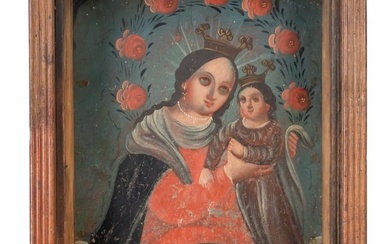19th C. Mexican Wood Santo - St. Anthony of Padua
Latin America, Mexico, ca. 19th century CE. A lovely hand-carved wooden santo depicting St. Anthony of Padua. He stands with sandaled feet atop an integral ovoid platform and wears flowing blue-painted robes with hanging sleeves, a large hooded collar, and a cream-hued belt with three knots representing poverty, chastity, and obedience. He presents a kind face with a friar's tonsure, red-painted lips, and inlaid glass eyes with amethyst-hued irises. Drilled holes in his wrists indicate he has hands which held implements at one time, and a pierced hole in his head is meant for a silver halo. Size: 5.5" W x 15.75" H (14 cm x 40 cm).
St. Anthony was a Portuguese Franciscan priest and friar who died in Padua, Italy. Despite being born into a wealthy family, he was known for his intense devotion to the poor and sick, and holds the distinction of being canonized most quickly of all the saints. He is also known as the patron saint of lost things - objects, people, and souls. In art, he is often depicted with a book and the infant Jesus, based on a commonly told story of him reading a book and seeing the Christ Child's image in it.
Santos played an important role in bringing the Catholic Church to the New World with the Spanish colonists. These religious figures were hand-carved and often furnished with crowns, jewels, and other accessories, usually funded by religious devotees, and were used as icons to explain the major figures - Mary, Christ, and the saints - to new, indigenous converts. Likewise, they served as a connection to the Old World for Spanish colonists far from home. They became a folk art tradition in the Spanish New World, from modern day Guatemala to as far north as New Mexico and Colorado. Many of them were lovingly cared for over the years, with repairs and paint added as they aged, and played an active part for a long time in the religious life of their communities.
Provenance: private California, USA collection
All items legal to buy/sell under U.S. Statute covering cultural patrimony Code 2600, CHAPTER 14, and are guaranteed to be as described or your money back.
A Certificate of Authenticity will accompany all winning bids.
We ship worldwide to most countries and handle all shipping in-house for your convenience.
#134952
Condition Report: Hands and other attachable accessories missing. Losses to parts of head, arms, and base. Small nicks to base, legs, body, and head, with chipping and fading to pigmentation, and light clouding to glass eyes. Nice earthen deposits as well as craquelure to pigment throughout.
View it on
Estimate
Time, Location
Auction House
Latin America, Mexico, ca. 19th century CE. A lovely hand-carved wooden santo depicting St. Anthony of Padua. He stands with sandaled feet atop an integral ovoid platform and wears flowing blue-painted robes with hanging sleeves, a large hooded collar, and a cream-hued belt with three knots representing poverty, chastity, and obedience. He presents a kind face with a friar's tonsure, red-painted lips, and inlaid glass eyes with amethyst-hued irises. Drilled holes in his wrists indicate he has hands which held implements at one time, and a pierced hole in his head is meant for a silver halo. Size: 5.5" W x 15.75" H (14 cm x 40 cm).
St. Anthony was a Portuguese Franciscan priest and friar who died in Padua, Italy. Despite being born into a wealthy family, he was known for his intense devotion to the poor and sick, and holds the distinction of being canonized most quickly of all the saints. He is also known as the patron saint of lost things - objects, people, and souls. In art, he is often depicted with a book and the infant Jesus, based on a commonly told story of him reading a book and seeing the Christ Child's image in it.
Santos played an important role in bringing the Catholic Church to the New World with the Spanish colonists. These religious figures were hand-carved and often furnished with crowns, jewels, and other accessories, usually funded by religious devotees, and were used as icons to explain the major figures - Mary, Christ, and the saints - to new, indigenous converts. Likewise, they served as a connection to the Old World for Spanish colonists far from home. They became a folk art tradition in the Spanish New World, from modern day Guatemala to as far north as New Mexico and Colorado. Many of them were lovingly cared for over the years, with repairs and paint added as they aged, and played an active part for a long time in the religious life of their communities.
Provenance: private California, USA collection
All items legal to buy/sell under U.S. Statute covering cultural patrimony Code 2600, CHAPTER 14, and are guaranteed to be as described or your money back.
A Certificate of Authenticity will accompany all winning bids.
We ship worldwide to most countries and handle all shipping in-house for your convenience.
#134952
Condition Report: Hands and other attachable accessories missing. Losses to parts of head, arms, and base. Small nicks to base, legs, body, and head, with chipping and fading to pigmentation, and light clouding to glass eyes. Nice earthen deposits as well as craquelure to pigment throughout.





